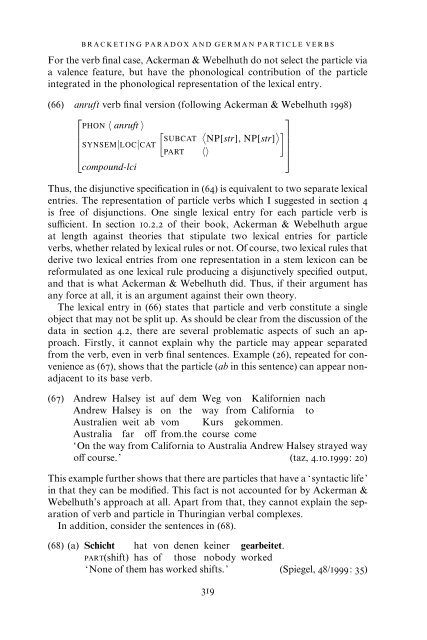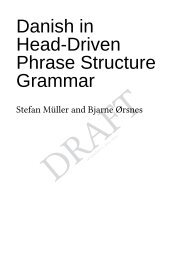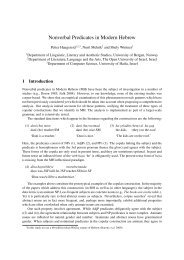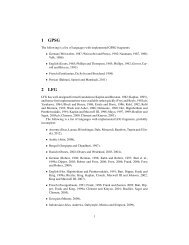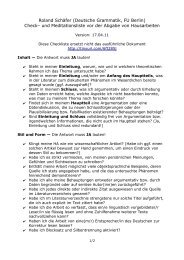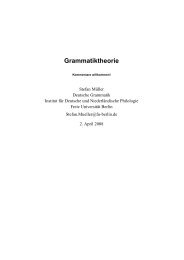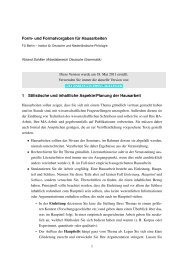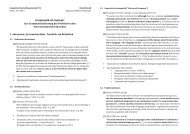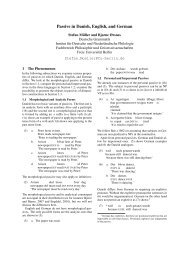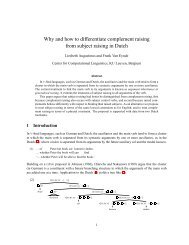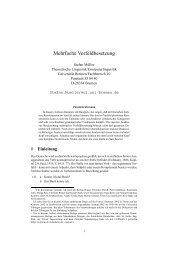Solving the bracketing paradox - German Grammar Group FU Berlin
Solving the bracketing paradox - German Grammar Group FU Berlin
Solving the bracketing paradox - German Grammar Group FU Berlin
Create successful ePaper yourself
Turn your PDF publications into a flip-book with our unique Google optimized e-Paper software.
BRACKETING PARADOX AND GERMAN PARTICLE VERBS<br />
For <strong>the</strong> verb final case, Ackerman & Webelhuth do not select <strong>the</strong> particle via<br />
a valence feature, but have <strong>the</strong> phonological contribution of <strong>the</strong> particle<br />
integrated in <strong>the</strong> phonological representation of <strong>the</strong> lexical entry.<br />
(66) anruft verb final version (following Ackerman & Webelhuth 1998)<br />
⎡<br />
⎤<br />
PHON 〈 anruft 〉<br />
[ 〈 〉]<br />
SUBCAT NP[str], NP[str] ⎢SYNSEM|LOC|CAT<br />
⎥<br />
⎣<br />
PART 〈〉<br />
⎦<br />
compound-lci<br />
Thus, <strong>the</strong> disjunctive specification in (64) is equivalent to two separate lexical<br />
entries. The representation of particle verbs which I suggested in section 4<br />
is free of disjunctions. One single lexical entry for each particle verb is<br />
sufficient. In section 10.2.2 of <strong>the</strong>ir book, Ackerman & Webelhuth argue<br />
at length against <strong>the</strong>ories that stipulate two lexical entries for particle<br />
verbs, whe<strong>the</strong>r related by lexical rules or not. Of course, two lexical rules that<br />
derive two lexical entries from one representation in a stem lexicon can be<br />
reformulated as one lexical rule producing a disjunctively specified output,<br />
and that is what Ackerman & Webelhuth did. Thus, if <strong>the</strong>ir argument has<br />
any force at all, it is an argument against <strong>the</strong>ir own <strong>the</strong>ory.<br />
The lexical entry in (66) states that particle and verb constitute a single<br />
object that may not be split up. As should be clear from <strong>the</strong> discussion of <strong>the</strong><br />
data in section 4.2, <strong>the</strong>re are several problematic aspects of such an approach.<br />
Firstly, it cannot explain why <strong>the</strong> particle may appear separated<br />
from <strong>the</strong> verb, even in verb final sentences. Example (26), repeated for convenience<br />
as (67), shows that <strong>the</strong> particle (ab in this sentence) can appear nonadjacent<br />
to its base verb.<br />
(67) Andrew Halsey ist auf dem Weg von Kalifornien nach<br />
Andrew Halsey is on <strong>the</strong> way from California to<br />
Australien weit ab vom Kurs gekommen.<br />
Australia far off from.<strong>the</strong> course come<br />
‘On <strong>the</strong> way from California to Australia Andrew Halsey strayed way<br />
off course.’ (taz, 4.10.1999: 20)<br />
This example fur<strong>the</strong>r shows that <strong>the</strong>re are particles that have a ‘syntactic life’<br />
in that <strong>the</strong>y can be modified. This fact is not accounted for by Ackerman &<br />
Webelhuth’s approach at all. Apart from that, <strong>the</strong>y cannot explain <strong>the</strong> separation<br />
of verb and particle in Thuringian verbal complexes.<br />
In addition, consider <strong>the</strong> sentences in (68).<br />
(68) (a) Schicht hat von denen keiner gearbeitet.<br />
PART(shift) has of those nobody worked<br />
‘None of <strong>the</strong>m has worked shifts.’ (Spiegel, 48/1999: 35)<br />
319


